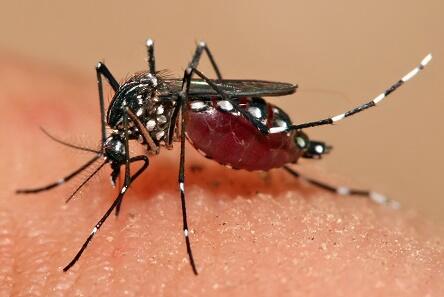
A collaboration between scientists in Liverpool and Brazil has found that targeting the very bottom of a room’s walls with insecticide will kill most of the mosquitoes present. This opens the door to a cheaper and easier way to treat houses in mosquito-prone areas during disease outbreaks.
The mosquito Aedes aegypti is a carrier of several serious diseases in urban areas, including dengue, chikungunya and Zika. One approach to their domestic control in Asia and Latin America has been indoor residual spraying, in which interior walls on which mosquitoes rest are coated with a persistent insecticide. However, the large surface areas involved require backpack sprayers and skilled operators to treat the home, making the approach expensive to implement. Drs Luca Facchinelli, Jeff Jones, and Prof. Philip McCall from Liverpool School of Tropical Medicine, UK and colleagues from Oswaldo Cruz Foundation in Recife, Brazil sought a more precise ‘kill zone’ to make indoor residual spraying cheaper and easier for individual householders to ‘do it themselves’.
The authors ran a series of experiments in Recife, Brazil using sticky strips mounted at different wall heights to explore where mosquitoes chose to rest in buildings. Most Aedes aegypti preferred to rest near the floor, with the majority found on the lowest 20cm of the wall (12% of the total wall surface). The hotter the room, the further down the mosquitoes tended to rest, as the lower parts of the room are typically cooler. Spraying this lower zone alone killed more than 85% of the mosquitoes in the house, and the approach was even more effective when the lower zone was coloured black. Householders could easily and cheaply apply insecticidal paint or an aerosolised insecticide to this accessible zone, breaking the dependency on expensive and logistically challenging house-to-house vertical controlled approaches.
Professor Philip McCall the study’s principal investigator, said: “So far, we have shown this mosquito behaviour only in an experimental semi-field setup, but we are now repeating the tests in real houses to confirm it will work on a larger scale. If it proves to be an effective method of vector control, it would permit cost-effective and sustainable mosquito control in a vast area where most of the human population lives under the threat of dengue, zika and other viruses. The benefits would be unprecedented.”
Funding for this study was provided by the UK’s Medical Research Council.
Further information
“Mapping Aedes aegypti indoor resting behavior reveals a preference vulnerable to householder-led vector control,” by Luca Facchinelli, Bashir Alsharif, Jeff D Jones, Agnes Matope, Rôsangela MR Barbosa, Constância FJ Ayres, Philip J McCall.